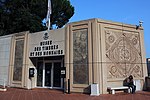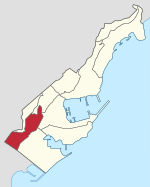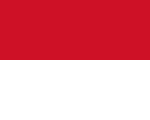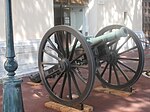Monaco ( MON-ə-koh, French: [mɔnako]; Monégasque: Mùnegu [ˈmuneɡu]), officially the Principality of Monaco, is a sovereign city-state and microstate on the French Riviera a few kilometres west of the Italian region of Liguria, in Western Europe, on the Mediterranean Sea. It is bordered by France to the north, east and west. The principality is home to 38,682 residents, of whom 9,486 are Monégasque nationals; it is widely recognised as one of the most expensive and wealthiest places in the world. The official language of the principality is French. In addition, Monégasque (a variety of Ligurian), English and Italian are spoken and understood by many residents.With an area of 2.02 km2 (0.78 sq mi), it is the second-smallest sovereign state in the world, after Vatican City. Its 19,009 inhabitants /km2 (49,230/sq mi) make it the most densely-populated sovereign state in the world. Monaco has a land border of 5.47 km (3.40 mi) and the world's shortest coastline of approximately 3.83 km (2.38 mi); it has a width that varies between 1,700 and 349 m (5,577 and 1,145 ft). The highest point in the state is a narrow pathway named Chemin des Révoires on the slopes of Mont Agel, in the Les Révoires ward, which is 161 m (528 ft) above sea level. The principality is about 15 km (9.3 mi) from the border with Italy. Since 2013, it consists of nine administrative wards, the largest of which is Monte Carlo (Monte Carlo/Spélugues, 0.44 km2 (0.17 sq mi)), and the most populous of which is Larvotto (Larvotto/Bas Moulins, 5,443 residents as of 2008). Through ongoing land reclamation, started in 1861 and accelerating in the 1960s, Monaco's small land mass has expanded by 20 per cent.
The principality is governed under a form of constitutional monarchy, with Prince Albert II as head of state, who wields immense political power despite his constitutional status. The prime minister, who is the head of government, can be either a Monégasque or a French citizen; the monarch consults with the Government of France before an appointment. Key members of the judiciary in Monaco are detached French magistrates. The House of Grimaldi has ruled Monaco, with brief interruptions, since 1297. The state's sovereignty was officially recognised by the Franco-Monégasque Treaty of 1861, with Monaco becoming a full United Nations voting member in 1993. Despite Monaco's independence and separate foreign policy, its defence is the responsibility of France, besides maintenance of two small military units.
Monaco's economic development was spurred in the late 19th century with the opening of the state's first casino, the Monte Carlo Casino, and a railway connection to Paris. Since then, Monaco's mild climate, scenery, and gambling facilities have contributed to the principality's status as a tourist destination and recreation centre for the rich. In more recent years, Monaco has become a major banking centre and has sought to diversify its economy into the services sector and small, high-value-added, non-polluting industries. Monaco is famous as a tax haven, as the principality has no personal income tax (except for French citizens) and low business taxes. Over 30% of the residents are millionaires, with real estate prices reaching €100,000 ($116,374) per square metre in 2018. Monaco is considered a global hub of money laundering, and in February 2023 was placed under review by the intergovernmental Financial Action Task Force watchdog, with the threat of being placed on its 'grey list', for its failures in financial supervision and reform to inhibit global criminality and terrorism financing.Monaco is not formally a part of the European Union (EU), but it participates in certain EU policies, including customs and border controls. Through its relationship with France, Monaco uses the euro as its sole currency; before, it used the Monegasque franc, which was pegged, and exchangeable with, the French franc until 1 January 2002. Monaco joined the Council of Europe in 2004 and is a member of the Organisation internationale de la Francophonie (OIF). It is also the host of the annual street circuit motor race, the Monaco Grand Prix, one of the original Grands Prix of Formula One. The local motorsports association gives name to the Monte Carlo Rally, hosted in January in the French Alps. The principality has a club football team, AS Monaco, which competes in the French Ligue 1 and have become French champions on multiple occasions, and a basketball team, which plays in the EuroLeague. A centre of research into marine conservation, Monaco is home to one of the world's first protected marine habitats, an Oceanographic Museum, and the International Atomic Energy Agency Environment Labs, which is the only marine laboratory in the United Nations structure.









